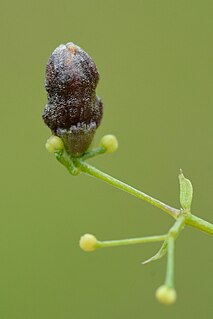
The Cecidomyiinae are a subfamily of flies often called gall midges or gall gnats.

Contarinia is a genus of midges, small flies in the family Cecidomyiidae.
Daphnephila truncicola is a species of gall midges first associated with stem galls on Lauraceae species, particularly Machilus thunbergii in Taiwan. Based on analysis on sequences of the mitochondrial cytochrome c oxidase subunit I, it has been suggested that in this genus, the stem-galling habit is a more ancestral state as opposed to the leaf-galling habit. This genus appears to have originated tropically and dispersed to Japan through Taiwan.
Daphnephila ornithocephala is a species of gall midge first associated with leaf galls on Lauraceae species, particularly Machilus thunbergii in Taiwan. Based on analysis on sequences of the mitochondrial cytochrome c oxidase subunit I, it has been suggested that in this genus, the stem-galling habit is a more ancestral state as opposed to the leaf-galling habit. This genus appears to have originated tropically and dispersed to Japan through Taiwan.

Rabdophaga is genus of flies in the family of gall midges Cecidomyiidae. There are 105 species distributed through Africa, Asia, Europe and North America. Most species of Rabdophaga gall willows ; one exception is R. giraudiana which galls the stems of poplars.

Schizomyia is a genus of gall midges. It has a cosmopolitan distribution.

Asphondyliini is a tribe of gall midges in the family Cecidomyiidae. There are about 6 genera and at least 100 described species in Asphondyliini.
Alycaulini is a tribe of gall midges, insects in the family Cecidomyiidae. There are about 20 genera and at least 200 described species in Alycaulini.
Polystepha is a genus of gall midges in the family Cecidomyiidae. There are at least 20 described species in Polystepha.
Celticecis is a genus of hackberry gall midges in the family Cecidomyiidae. There are about 18 described species in Celticecis.
Parallelodiplosis is a genus of gall midges, insects in the family Cecidomyiidae. There are at least 20 described species in Parallelodiplosis.
Catotricha is a genus of gall midges and wood midges in the family Cecidomyiidae, the only genus in the subfamily Catotrichinae. There are about six described species in Catotricha.
Cystiphora is a genus of gall midges in the family Cecidomyiidae. There are about seven described species in Cystiphora.
Resseliella is a genus of gall midges in the family Cecidomyiidae. There are at least 50 described species in Resseliella.
Blaesodiplosis is a genus of gall midges in the family Cecidomyiidae. There are at least four described species in Blaesodiplosis.
Janetiella is a genus of gall midges in the family Cecidomyiidae. There are at least 30 described species in Janetiella.
Prodiplosis is a genus of gall midges, insects in the family Cecidomyiidae. There are about 11 described species in Prodiplosis.
Dicrodiplosis is a genus of gall midges in the family Cecidomyiidae. There are about 15 described species in Dicrodiplosis.
Daphnephila is a genus of gall midge that appears in the Palearctic and Oriental biogeographic realms. Daphnephila species create leaf and stem galls on species of laurel plants, particularly in Machilus. Based on analysis on sequences of the mitochondrial cytochrome c oxidase subunit I, it has been suggested that in this genus, the stem-galling habit is a more ancestral state as opposed to the leaf-galling habit.





